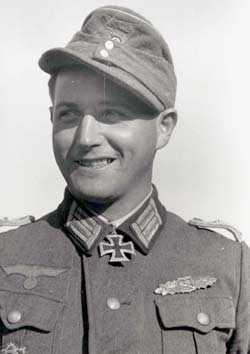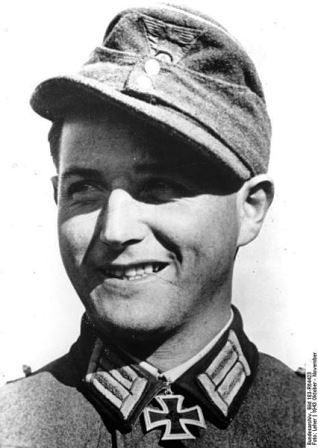Franz, Ludwig (Grenadier-Regiment 35)
- Date of birth:
- September 3rd, 1915 (Schramberg/Württemberg, Germany)
- Date of death:
- July 5th, 1944 (Beleja-Luscha/Belarus, Soviet Union)
- Nationality:
- German (1933-1945, Third Reich)
Biography
Ludwig Franz was posthumously promoted to Oberstleutnant der Reserve.
Do you have more information about this person? Inform us!
- Period:
- Second World War (1939-1945)
- Rank:
- Oberleutnant der Reserve (1st Lieutenant of Reserves)
- Unit:
- 10. Kompanie, III. Bataillon, Infanterie-Regiment 35 (motorisiert), 25. Infanterie-Division (motorisiert), Heer
- Awarded on:
- April 19th, 1942
- Period:
- Second World War (1939-1945)
- Rank:
- Hauptmann der Reserve (Captain of Reserves)
- Unit:
- Führer, I. Bataillon, Grenadier-Regiment 35, 25. Panzergrenadier-Division, Heer
- Awarded on:
- October 8th, 1943
“In the fighting west of Smolensk (which was very costly for the enemy) the Soviets attacked the sector of a Panzergrenadier-Division with a mechanized corps and a rifle division. For a full two days the main force of the enemy attack fell against the sector of Hauptmann Franz’s Panzergrenadier-Bataillon. Yet even amidst the heaviest of enemy fire he was able to maintain contact with his Kompanien and attached weapons from his foxhole. Although the improvised command post was fired upon non-stop by the Soviets, he nonetheless led his Grenadiers through the repeated enemy penetrations from the front and flanks. He personally intervened in the fighting with rifle and hand grenade during hours of close combat in order to defeat the Soviets. After he had been buried alive for a long time in his foxhole by a Soviet tank, and removed only with great difficulty, the Hauptmann continued to lead his Bataillon in further fighting. 45 tanks were already destroyed, and hundreds of dead Red Army soldiers covered the battlefield. However now the enemy succeeded in penetrating through the ranks of the Panzergrenadiers, who had been worn down by the fighting that had gone on for the whole day. The Bataillon commander continued to lead the defense (now partially in the Soviet rear) long enough for a new defensive line to be constructed. The counterthrusts from the old frontline that he led with just a few men enabled the reinforcing of the new positions. Then, with 20 men he collected from various resistance nests, he broke through to friendly lines. This was at at end of 48 hours of heavy combat. The enemy had sustained such high losses during their assault that they no longer had the strength to effectively continue their attacks against the new positions. With this the Bataillon commander had frustrated the far-reaching aims of an entire Soviet shock army.”
Note: According to a different newspaper article Franz’s Bataillon was reported as destroying 15 enemy tanks during this battle rather than 45. It is far more likely that this represents the true number of enemy tanks destroyed in Franz’s sector. Thus the report of 45 tanks here is either a mistake or deliberate exaggeration.
- Period:
- Second World War (1939-1945)
- Period:
- Second World War (1939-1945)
- Period:
- Second World War (1939-1945)
Sources
- Photo: TITLE
- File:Bundesarchiv Bild 183-R64423, Ludwig Franz.jpg - Wikimedia Commons - - FELLGIEBEL, W.P., Elite of theThird Reich, Helion & Company Limited, Solihull, 2003.
- PATZWALL, K. & SCHERZER, V., Das Deutsche Kreuz 1941-1945, Verlag Klaus D. Patzwall, Norderstedt, 2001.
- WEGMANN, GÜNTER, Die Ritterkreuzträger der Deutschen Wehrmacht 1939-1945, Biblio Verlag, Osnabrück, 2010.








